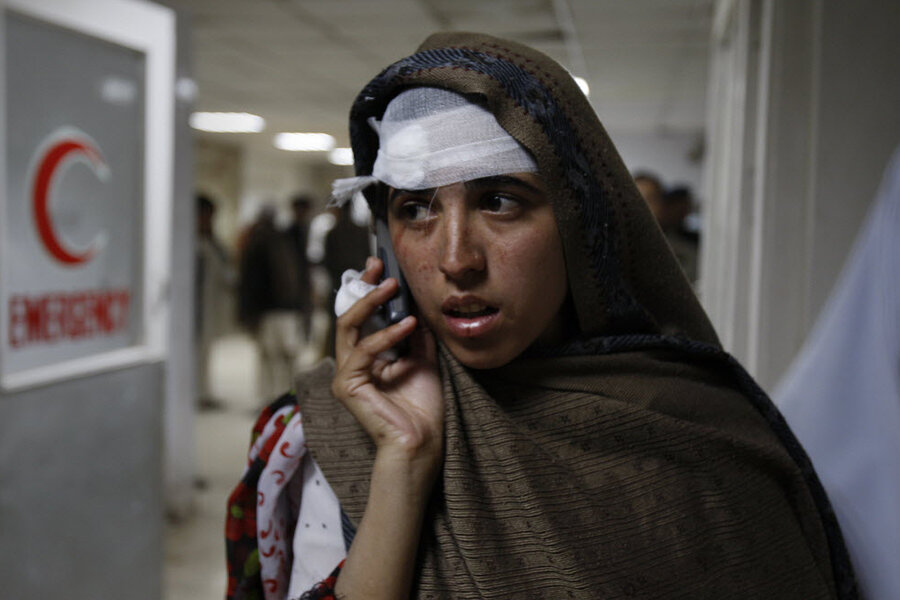Taliban attack on Pakistani airport highlights changed tactics
Loading...
| Islamabad, Pakistan
Pakistani security forces reestablished control today over one of the country's international airports after Taliban militants stormed the installation, in an attack that highlights the group's recent focus on higher-profile and official targets.
Ten men from the Tehreek-e-Taliban Pakistan (TTP) attacked the airport with automatic weapons, grenades, and mortars late Saturday in Pakistan's northwestern provincial capital of Peshawar. Six people were killed after a six hour stand-off between the militants and Pakistani police and troops.
Even though the airport is used by civilians for local and international travel, it is also used by the Pakistan Air Force (PAF) for operations in Pakistan's tribal belt – making it a strategic target for the TTP. The last major attack on a military air base in Pakistan took place four months ago when insurgents wearing suicide vests stormed Minhas Air Base, a PAF installation in the northern part of Pakistan's largest province, Punjab.
According to security analysts, the attack on Peshawar airport indicates a fundamental shift in militant strategy. According to the Pakistan Institute of Peace Studies, overall terrorist attacks have decreased over the last two years – down by 46 percent in the first half of 2012 compared to 2011. However, according to data collected by the Islamabad-based think tank, Center for Research and Security Studies (CRSS), targeted attacks have increased. Compared to 2011, there has been a 25 percent increase in attacks on the paramilitary and police, and a 17 percent increase in attacks on prominent personalities this year.
“This attack is a sign that militants have changed their tactics. Rather than attacking the common man, which entails greater condemnation, they have now started attacking the people or institutions that are supposed to protect the people,” says Imtiaz Gul, the executive director of the CRSS.
According to Mr. Gul, attacks between 2008 and 2010 on public transport, markets, and school buses, where thousands of civilians were killed, discredited militants and weakened their support in the general public. The overall decrease in attacks, paired with an increase in targeted attacks, points to a far more focused TTP that is interested in deflecting the security forces from the smaller operations going on in the tribal belt's Orakzai and Khyber Agencies, according to Gul.
“The attack in Peshawar underlines a security lapse,” says Gul. The airport sits in a populated area, making it vulnerable to begin with according to Gul. However, the shift in strategy, the joint use of the airport, and its clear vulnerability should have alerted security forces.
Amir Rana, the Director of Pakistan Institute of Peace Studies, disagrees.
“The surveillance level of the Army is in tact. That is why this attack was not as successful as Mehran,” says Rana, referring to a May 2011 shooting carried out by the TTP against the Pakistan Naval Base Mehran in Pakistan's commercial capital, Karachi, where 15 militants killed 18 military personnel and wounded an additional 16.
“Of course, we cannot completely stop these attacks – that will take time. But the capacity is there. This is fundamentally a question of coordination,” says Rana. According to Rana, inefficient intelligence-sharing and a gap in trust levels between law enforcement agencies makes it more difficult to respond effectively.
“The Federal Cabinet just passed the National Counter Terrorism Authority (NACTA) bill last month. It attempts to address these issues. So let it unfold, and lets see what happens,” says Rana.
But skepticism is high about NACTA. Research from Express Tribune's Zahid Gishkori shows that while the counterterrorism authority spent more than $5 million (Rs. 524 million) in the last four years since it was established, it has only produced “a brief documentary and a couple of research papers.”
“We haven't done enough intellectual work on this front. There is no systemic or sustained response, where we have an all-encompassing strategy including the police, community, and political leadership. There is still far to go,” says Gul.






